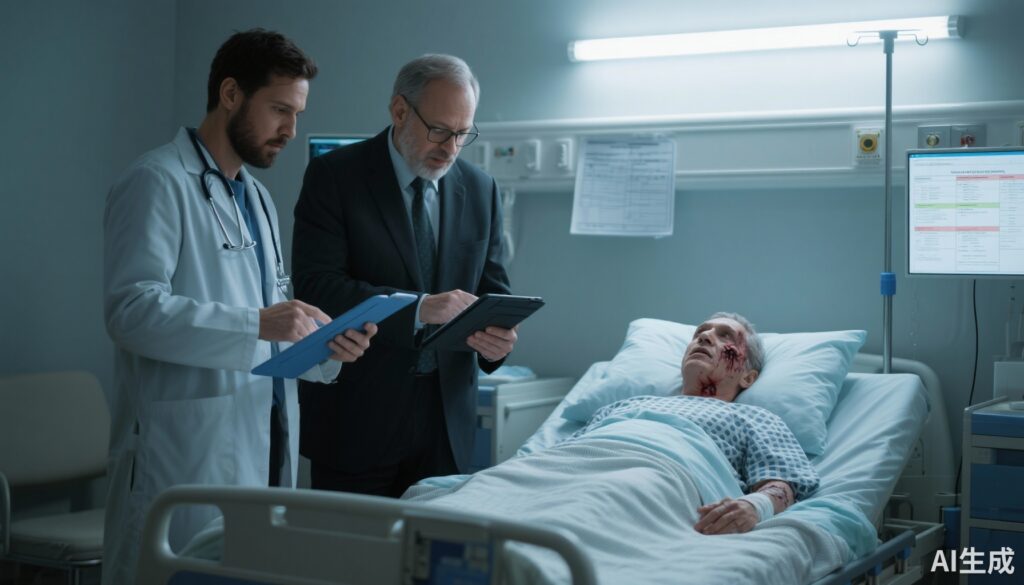Introduction and Context
Traumatic physical injury is a common trigger for new or worsening mental-health problems. Anxiety, acute stress reactions, posttraumatic stress disorder (PTSD), depression, substance-use disorder, and behavioral dysregulation (including aggression) commonly follow both single-event and repetitive injuries. In the acute and early recovery phases (the first 3 months after injury) clinicians working in emergency departments, trauma services, and acute rehabilitation must make rapid decisions about screening, triage, early interventions, and pathways for follow-up care.
Until recently, guidance for these early decisions was dispersed across specialty guidelines (e.g., psychiatry, brain-injury care, emergency medicine) and varied in quality and applicability. The systematic review by Bérubé et al. (JAMA Surgery, 2025) pooled and appraised recommendations from 43 clinical practice guidelines (CPGs) focused on mental health in trauma during the acute and early recovery phases. Their work offers clinicians a consolidated view of what guideline authors now recommend, which recommendations have stronger empirical support, and which areas need research and system-level investment.
Why this synthesis matters now: more trauma survivors are living with treatable mental disorders, and health systems are under pressure to implement evidence-based care efficiently. The review identifies a focused set of recommendations that are best supported by moderate-to-high quality evidence and therefore most suitable for early implementation in clinical settings.
New Guideline Highlights
Major themes and takeaways from the review:
– Scope and quality: 43 CPGs were identified; 25 (58%) were rated high quality using the AGREE II tool. Many guidelines, however, showed methodological weaknesses in development rigor, applicability, stakeholder involvement, and editorial independence.
– Volume and strength of recommendations: Across high-quality guidelines there were 200 discrete recommendations relevant to acute/early mental-health care; only 50 (25%) were supported by moderate- to high-quality evidence when synthesized using a GRADE-based matrix. Notably, 30 of these 50 evidence-supported recommendations (60%) addressed traumatic brain injury (TBI) populations.
– Content focus: The best-supported recommendations largely concern active treatment (nonpharmacological and pharmacological) for acute stress disorder (ASD), PTSD, depression, substance use disorders, and aggression. Recommendations about prevention, routine screening, early evaluation, and structured referral pathways were more commonly made but less frequently supported by high-quality empirical data.
Key immediate actions for clinicians (prioritized):
1. Screen for acute suicidality, severe depression, and active substance use in all trauma inpatients and emergency presentations using brief validated tools (e.g., PHQ-9, C-SSRS, AUDIT-C).
2. For patients with suspected ASD or symptoms of PTSD within the first month, consider early trauma-focused psychotherapy (when available) and arrange prompt follow-up; avoid routine benzodiazepines for acute stress reactions.
3. In TBI patients, adapt screening and therapy modalities for cognitive impairment; prioritize multidisciplinary collaboration (rehabilitation, psychiatry, neurology).
Updated Recommendations and Key Changes
The systematic review assimilated a heterogeneous set of CPGs (different years, organizations, and target populations). Highlights of changes emphasized by guideline authors and the review team include:
– Greater prominence of TBI-specific mental-health guidance: Compared with earlier guidance, recent CPGs include more TBI-tailored recommendations addressing pharmacologic choices, cognitive-capacity–adapted psychotherapies, and structured follow-up pathways.
– Caution on routine pharmacologic preventive therapy: Earlier, some clinicians used medications prophylactically to prevent PTSD after trauma. Contemporary CPGs increasingly discourage routine pharmacologic prevention for unselected trauma-exposed patients because evidence of benefit is limited and risks exist.
– Stronger language against benzodiazepines: Most modern CPGs advise against routine benzodiazepine use for acute stress reactions or PTSD due to risk of dependence and possible interference with trauma processing.
– Rising emphasis on implementation factors: Newer guidance increasingly points to clinician training, integrated care pathways, and equity considerations as essential for translating recommendations into practice—areas that earlier guidelines tended to neglect.
Why the updates occurred: accumulating randomized-trial data for trauma-focused psychotherapies and longer-term outcome studies in brain-injury populations, alongside broader awareness about harms from some early acute-phase medications.
Topic-by-Topic Recommendations
Below are practical, guideline-informed recommendations arranged for clinicians working in acute and early recovery settings. Where possible, we note the strength of evidence (generalized from the review’s GRADE-based synthesis).
Screening and early identification
– Universal basic triage: All adult trauma patients should undergo immediate assessment for acute safety risks (suicide, agitation, intoxication) in the ED or trauma bay (strong recommendation; low–moderate evidence). Tools: PHQ-9 for depression, C-SSRS for suicide risk, brief substance-use screen (AUDIT-C).
– PTSD/ASD symptom screening: Use brief validated instruments (PCL-5, PC-PTSD-5) selectively—particularly for those with risk factors (prior mental illness, severe injury, prolonged ICU stay) rather than universal screening of all patients (conditional recommendation; limited evidence).
Risk stratification and early referral
– High-risk triage: Patients with positive screens for suicidality, severe depression, active substance dependence, or severe ASD should have expedited psychiatry/psychology consultation and a safety plan prior to discharge (strong recommendation; moderate evidence).
– TBI-specific caution: Standard PTSD screening instruments may be less reliable in patients with significant cognitive deficits; use clinician assessment and cognitive-capacity–adapted tools and involve neurology/rehab early (conditional recommendation; low evidence).
Prevention and immediate interventions
– Psychological first aid (PFA) and practical support: Offer early, nonintrusive support and information (PFA) to all trauma survivors; this is recommended as good practice though trial evidence is limited (good-practice recommendation).
– Pharmacologic prevention: Routine prophylactic SSRIs or other medications to prevent PTSD in unselected trauma-exposed patients is not recommended (conditional recommendation against; low–moderate evidence).
Treatment of acute stress disorder and early PTSD
– Trauma-focused psychotherapies (early): For patients meeting criteria for ASD or early PTSD symptoms, trauma-focused cognitive behavioral therapy (TF-CBT) or eye movement desensitization and reprocessing (EMDR) are recommended when available (strong recommendation for established PTSD; conditional for very early ASD; moderate evidence).
– Pharmacotherapy for acute PTSD: SSRIs (sertraline, paroxetine, fluoxetine) have evidence for PTSD treatment in chronic phases; evidence for short-term use in the immediate aftermath (<3 months) is less robust—use when psychotherapy is unavailable or when comorbid depression necessitates treatment (conditional recommendation; moderate evidence for established PTSD, low for very early use).
– Benzodiazepines: Avoid routine benzodiazepine use for the treatment of ASD or PTSD due to lack of benefit and potential harms (strong consensus; low evidence but high harm signals).
Management of depression and suicidality after injury
– Treat major depressive episodes with standard approaches (psychotherapy and/or antidepressants) adapted to injury-related constraints; prioritize safety planning and rapid access to follow-up for suicide risk (strong recommendation; moderate evidence).
Substance use and behavioral dysregulation
– Screen and brief intervention: Offer screening and brief interventions for risky alcohol and drug use; refer for specialized addiction services when moderate-to-high-risk use is identified (strong recommendation; moderate evidence).
– Aggression/behavioural disturbance: Manage acute agitation per local protocols; consider psychiatric consult and neuropsychiatric assessment—especially in TBI patients where behavioral dysregulation may reflect frontal-lobe injury (conditional recommendation; limited evidence).
Follow-up and care pathways
– Structured follow-up: Arrange timely follow-up (within 1–4 weeks) for patients with any positive mental-health screening or those at high risk; provide a clear pathway for access to specialist mental-health or TBI-rehabilitation services (strong recommendation; limited-moderate evidence).
– Integrated models: Collaborative care or stepped-care approaches that embed mental-health professionals in trauma services show promise and are recommended as implementation priorities where resources permit (conditional recommendation; emerging evidence).
Recommendation grading—practical snapshot (synthesized guidance):
– Strong recommendation, moderate–high evidence: Immediate safety assessment (suicide, intoxication), treatment of major depression and suicidality, avoid benzodiazepines for PTSD/ASD.
– Conditional recommendation, low–moderate evidence: Early trauma-focused psychotherapy for ASD, selective pharmacotherapy for PTSD in acute phase when indicated, screening for PTSD/ASD in higher-risk groups.
– Good-practice (consensus): Psychological first aid, patient-and-family-centered communication, and documented follow-up plans.
Expert Commentary and Insights
The review team and the guideline panels they assessed converged on several shared expert views and also highlighted areas of controversy.
Consensus views and practical wisdom
– Prioritize safety, suicidality screening, and substance-use detection. These actions are low-cost, high-yield, and have the most robust rationale for implementation across settings.
– Invest in rapid-access pathways: prompt outpatient behavioral-health appointments, nurse-led follow-up calls, or embedded mental-health clinicians in trauma services substantially increase the chance that early symptoms are treated before they become chronic.
– TBI matters: TBI survivors need adapted approaches—standard screening tools and psychotherapies may need adjustment for cognitive deficits; pharmacologic choices should consider seizure risk, sleep, and cognition.
Key controversies and uncertainties
– Universal vs targeted PTSD screening: There is no high-quality evidence that universal PTSD screening in all trauma survivors improves outcomes. Panels differ; the pragmatic view favors targeted screening for patients with high-risk features.
– Early pharmacologic prevention: The evidence base does not support routine use of medications to prevent PTSD; some experts note this leaves a gap for high-risk patients where early intervention may theoretically help but trials are lacking.
– Best model of care: Whether collaborative-care models, embedded trauma-psychiatry, or rapid outpatient clinics are the most feasible and effective organizational approach remains debated and dependent on health-system resources.
Future trends and research needs
– Trials of early interventions (both psychotherapeutic and pharmacologic) in high-risk trauma subpopulations, including TBI, to guide preventive strategies.
– Implementation research examining how to integrate mental-health screening and treatment within busy trauma systems, and how to train nonmental-health clinicians effectively.
– Equity-focused studies to ensure vulnerable populations (e.g., uninsured, minority, rural survivors) receive equitable mental-health care after injury.
Practical Implications for Clinical Practice
How should clinicians and systems act on this synthesis?
1. Embed basic mental-health triage in trauma workflows: standardize suicide, depression and substance use screening with clear escalation rules.
2. Create rapid referral pathways: guaranteed follow-up appointments or telephone outreach for anyone who screens positive.
3. Train trauma clinicians in brief psychosocial interventions (psychological first aid, brief motivational interviewing) and in recognizing TBI-specific mental-health issues.
4. Avoid low-value practices such as routine benzodiazepine prescriptions for acute stress reactions and unselected pharmacologic prevention of PTSD.
5. For health systems: invest where possible in collaborative-care models or co-located mental-health providers in trauma services—these show promise for improving uptake of evidence-based care.
A brief clinical vignette
James Miller, a 42-year-old construction worker, is admitted after a motor-vehicle collision. He is medically stable but reports poor sleep, intrusive memories, and alcohol use to cope. A brief ED screen identifies high suicide risk and risky alcohol use. Per the prioritized recommendations above, James receives an immediate safety plan, bedside counseling by a social worker using PFA principles, and an expedited psychiatry consult before discharge. He is enrolled in a rapid outpatient follow-up program and offered trauma-focused psychotherapy; benzodiazepines are avoided. A TBI screen is negative, so standard CBT for his early PTSD symptoms is initiated. This pathway illustrates how simple triage and expedited referral can translate guideline recommendations into practice.
References
1. Bérubé M, Lapierre A, Panenka W, et al. Clinical Practice Guideline Recommendations on Mental Health in Trauma: A Systematic Review. JAMA Surg. 2025 Oct 1;160(10):1138-1155. doi:10.1001/jamasurg.2025.2226.
2. Brouwers MC, Kho ME, Browman GP, et al; AGREE Next Steps Consortium. AGREE II: advancing guideline development, reporting and evaluation in health care. CMAJ. 2010 Dec 14;182(18):E839-42. doi:10.1503/cmaj.090449.
3. Guyatt GH, Oxman AD, Vist GE, et al. GRADE: an emerging consensus on rating quality of evidence and strength of recommendations. BMJ. 2008 Apr 26;336(7650):924-6. doi:10.1136/bmj.39489.470347.AD.
4. VA/DoD Clinical Practice Guideline for the Management of Posttraumatic Stress Disorder and Acute Stress Reaction. U.S. Department of Veterans Affairs and Department of Defense. 2017. Available at: https://www.healthquality.va.gov/guidelines/MH/ptsd/
5. Bisson JI, Roberts NP, Andrew M, Cooper R, Lewis C. Psychological therapies for chronic post-traumatic stress disorder (PTSD) in adults. Cochrane Database Syst Rev. 2013 Dec 12;(12):CD003388. doi:10.1002/14651858.CD003388.pub4.
6. American Psychiatric Association. Diagnostic and Statistical Manual of Mental Disorders, 5th ed. Arlington, VA: American Psychiatric Association; 2013.
7. National Institute for Health and Care Excellence (NICE). Post-traumatic stress disorder: recognition and management. Clinical guideline [CG26] (updated). NICE; 2018. https://www.nice.org.uk/guidance/cg26
8. World Health Organization. Psychological first aid: Guide for field workers. WHO; 2011. https://www.who.int/publications/i/item/9789241548205
(Notes: The references above include the primary systematic review summarized here and widely used guideline tools and major PTSD guideline sources. Clinicians should consult their local or specialty-specific CPGs for jurisdictional recommendations and outpatient-resource pathways.)



